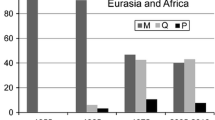Summary
The Drosophila melanogaster mobile DNA sequences P factors and P elements transpose at elevated rates when P strain males are mated to M strain females in a hybrid dysgenic cross (Engels 1983). Isofemale lines derived from such a cross were analysed by in situ hybridisation using cloned copies of the transposable elements copia, 412 and F. It was found that lines derived from dysgenic crosses showed a statistically significant number of new sites for these elements when compared to a non-dysgenic control cross. This result suggests a functional coupling of copia, 412 and F transposition and some component present in the P-M dysgenic system.
Similar content being viewed by others
References
Bridges CB (1935) Salivary chromosome maps. J Hered 26:60–64
DiNocera PP, Digan ME, Dawid IB (1983) A family of oligoadenylate-terminated transposable sequences in Drosophila melanogaster. J Mol Biol 168:715–727
Engels WR (1983) The P family of transposable elements in Drosophia. A Rev Genet 17:315–344
Feinberg AP, Vogelstein B (1984) A technique for radiolabeling DNA restriction endonuclease fragments to high specific activity. Anal Biochem 132:6–13
Flavell AJ, Ish-Horowicz D (1983) The origin of extrachromosomal circular copia elements. Cell 34:415–419
Flavell AJ (1984) Role of reverse transcription in the generation of extrachromosomal copia mobile genetic elements. Nature 310:514–516
Gerasimova TI, Mizrokhi LJ, Georgiev GP (1984) Transposition bursts in genetically unstable Drosohpila melanogaster. Nature 309:714–716
Gerasimova TI, Matjunina LV, Mizrokhi LJ, Georgiev GP (1985) Successive transposition explosions in Drosophila melanogaster and reverse transpositions of mobile dispersed genetic elements. EMBO J 4:3773–3779
Karess RE, Rubin GM (1984) Analysis of P transposable element functions in Drosophila. Cell 38:135–146
Kidwell MG, Kidwell JF, Sved JA (1977) Hybrid dysgenesis in Drosophila melanogaster: a syndrome of aberrant traits including mutation, sterility and male recombination. Genetics 86:813–833
Kidwell MG, Novy JB (1979) Hybrid dysgenesis in Drosophila melanogaster: sterility resulting from gonadal dysgenesis in the P-M system. Genetics 92:1127–1140
Kidwell MG (1981) Hybrid dysgenesis in Drosophila melanogaster: the genetics of cytotype determination in a neutral strain. Genetics 98:275–290
Rubin GM, Brorein WJ, Dunsmuir P, Flavell AJ, Levis R, Strobel E, Toole JJ, Young E (1981) Copia-like transposable elements in the Drosophila genome. Cold Spring Harb Symp Quant Biol 45:619–628
Rubin GM, Kidwell MG, Bingham PM (1982) The molecular basis of P-M hybrid dysgenesis: the nature of induced mutations. Cell 29:987–994
Shrimpton AE, Montgomery EA, Langley CH (1986) Om mutations in Drosophila ananassae are linked to insertions of a transposable element. Genetics 114:125–135
Author information
Authors and Affiliations
Additional information
Communicated by D.J. Finnegan
Rights and permissions
About this article
Cite this article
Lewis, A.P., Brookfield, J.F.Y. Movement of Drosophila melanogaster transposable elements other than P elements in a P-M hybrid dysgenic cross. Mol Gen Genet 208, 506–510 (1987). https://doi.org/10.1007/BF00328147
Received:
Issue Date:
DOI: https://doi.org/10.1007/BF00328147




